page 2
~ The Study of Threes ~
http://threesology.org
| Hybrids page 1 | Hybrids page 2 | Hybrids page 3 | Hybrids page 4 | Hybrids page 5 |
| Hybrids page 6 | Hybrids page 7 | Hybrids page 8 | Hybrids page 9 | Hybrids page 10 |
| Hybrids page 11 | Hybrids page 12 Playmate God |
Hybrids 13 Economics 1 |
Hybrids 14 Economics 2 |
Hybrids 15 Economics 3 |
| Hybrids 16 Economics 4 |
Hybrids 17 Economics 5 |
Hybrids 18 Economics 6 |
Hybrids 19 Economics 7 |
Hybrids 20 Language 1 |
| Hybrids 21 Language 2 |
Hybrids 22 Language 3 |
Hybrids 23 Language 4 |
Hybrids 24 Physics |
Hybrids 25 |
| Hybrids 26 | Hybrid 27 |
Visitors as of 30th July, 2021

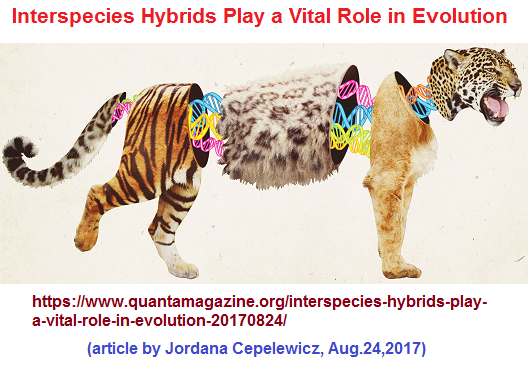
Interspecies Hybrids Play a Vital Role in Evolution
If we say that a hybrid is anything which deviates from a norm, we need to define what "normal" means... if other than described as common, usual, typical, or common-place. If the word hybrid is used to designate an arbitrary assessment which others come to agree with according to some perceived authoritative standard, why does the arbitrariness persistently exhibit certain patterns of cognitive activity which we can use numerical values to clarify? If Natural numbers are all hybrids, then why do some of these hybrids continue to crop up in different subjects with such a regularity, as well as exhibit a conformity to some largely unrecognized conservation?
Let us take for example the occasion in which mythological creatures have the head of one thing and the body of another. This not only is a two-pattern, but a recurring theme across culture and time. Let us thus count it as one example of a cognitive standard which may again occasion itself in chemical, biological, mechanical, architectural, etc., applications, where the items of "head" and "body" are not necessarily similarly named, but are altered nonetheless. In other words, two items in a different subject area which can constitute a head and a body may well be "hybridated" in the same manner as some ancient mythological creature... whereby the cognitive standard crops up again. Whereas in some instances we have the words "head" and "body" being used such as "Heading" and "body" of an article, other items may not do so but are similarly organized by layout and/or usage. Analogously, we use the terms "male" and "female" ends to describe the insertion and receiving ends such as in the case of plumbing parts; those body parts which were repeatedly addressed by modifications in the past for mythological creatures, take place in current activities involving the different subjects. It is not too difficult for many readers to see the headlamps of a vehicle as eyes and the front grill as the mouth or face region. Whether we are intending to deliberately anthropomorphize or not, it occurs quite often.
We have such examples as the head of a trail or the tail end of a task or journey. No less, we use the phrase "heart" of a problem and "soul" brother. Some claim that plants have feelings and animals know what we are thinking. Indeed, many a child treats a doll or stuffed animal as if it were alive. The cognitive distance between the child and adult is not that far for many people, as attested to by the belief in ghosts, goblins, witches, superstitions, gods, demons, etc.. Whereby it should be no surprise that we of the present can harbor many cognitive inclinations used in the past, but applied to current themes of interest and activity. While words and those involved in a given perspective can provide the illusion and pretended sophistication by way of a specific vocabulary, the truth is that old themes of cognitive exercise are alive and well. Hence, by illustrating the recurrent themes of hybridization of ancient perspectives, we can closer to cognitively apprehending a repetition being played out in the present. If you look too closely at people and overall society, you see that the fearfulness of the past is very much in fashion today. For example, you may have several neighbors but have never spoken to them and they not to you. You don't know if someone in the neighbor could help you with a household problem or some medical issue. Fearfulness is rampant. I found this to be true with friends I knew in childhood who did not recognize me, and even when they knew who I was, were afraid to speak with me until we were in a position and place which made them feel protected and comfortable... Whereas my radical and unconventional ideas in my youth were defined as an accepted "craziness" or free thinker, later years have made so many of my former acquaintances particularly conservative in their views. They don't want the presumed safety and security of their conservative life style interrupted by "irregular" considerations. It is particularly astonishing to find out how most of them did not and do not pursue additional education and alternative views.
By noting the types and quantities of specificities in hybrid combinations, we can serve to present ourselves with information regarding a type of cognitive ordering (and loading of information) to assess how this (presumed) conservation is taking place and how this is being accomplished. The conservation in this regard is the repetitive usage of a handful of combinations being used again and again, as if they were part of a series of natural laws governing cognitive behavior. Take the binomial nomenclature (as a two-name naming system) used in biology and then compare it to the Binary code ("binomial nomenclature") used in computer language assigned with the values of zeros and ones. If we add other two-patterned themes to this list and expand it to include other numbers, we come to realize that only a handful are being repetitively used.
Here are some examples of binary usage which can also be labeled as two-patterned Hybrids:
- Upper case/Lower case (letters of the alphabet)
- Metric scale/Imperial scale (such as on tape measures)
- Celsius/Fahrenheit (on thermometers)
- Single spaced (versus) Double spaced (reports, homework, etc...)
- Blouse for women/Shirt for men
- Woman's rights/Man's rights
- Left/Right (politics)
- Lefty loosey/Righty tighty (rule of thumb expression for turning most bolts, nuts, screws, jar lids, etc...)
- Right side/Wrong side of bed
- Infancy to old age/Old age to infancy (frequent occurrence of cognitive functioning)
- Life/Death
- Nature/Nurture
- Double beam/Triple beam (scales used for experimental accuracy)
- Paper standard/Gold standard {monometallism and bimetallism}; (monetary standards)
Monetary Standards
- 3 Standards of Monetary Systems by Sanket Suman (Gold standard, Gold Exchange standard, Paper standard)
- Bilipid cell layer/Trilaminar cell layer
- Driving on the left side of the road (England, etc...)/Driving on the right side of the road (U.S., etc...)
- Analog/Digital
Note: I have added several other items to the following list. The original can be seen here:
The cause and origin of the distinction between digital and analog are rarely discussed
by Jan Krikke, Jan 28, 2020
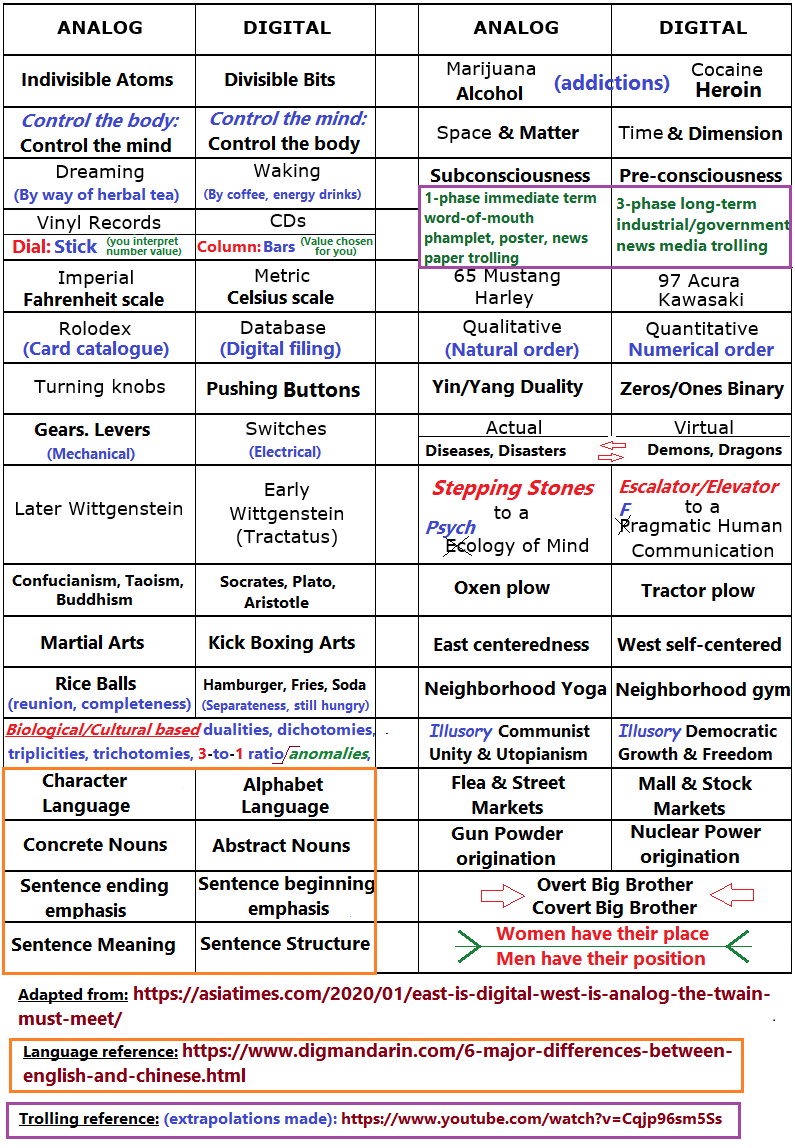
Despite the above author's contention about East and West, a closer look reveals not only the use of a list of dichotomies, but that in some cases the roles of Analog and Digital can be seen reversed, inter-changeable, as well as shared... to everyone's benefit and everyone's loss. While both East and West have histories of using analog an digital devices, we would no doubt cite together that analog preceded digital, but this does not mean that there is never any regression or 'stepping over' (called punctuated equilibrium in biology) what might be expected to be a sequential step from analog to digital. It also is important to note that we cannot, as is noted by several of the dichotomous examples; look upon the labels of analog and digital in terms of technology alone... (as is brought out in the article). Biological development as well as behavior on the individual and larger societal dimension need to be surveyed to supply us with a more comprehensive perspective of how the analog/digital duality has, does, and may futuristically play-out such as in the fashion of: (both complementary— as in the case of Yin/Yank, and antagonistically— as in the case of ideological conflicts which bring people to effecting combatant activities such as war and economic rivalries/stalemates).
The author's comment: "Analog computers rely on the continuous variation of voltage, while digital computers deal only with discrete, unambiguous current – either on or off."... is problematic, since it presents us with an analogy that is reversed, when we compare analog and digital to Alternating and Direct current behavior. Let us look at the definitions of AC and DC currents:
- What is AC power? Alternating current (AC) power is the standard electricity that comes out of power outlets and is defined as a flow of charge that exhibits a periodic change in direction.
- What is DC power? Direct current (DC) power, as you may suss (realize or grasp) from the name, is a linear electrical current—it moves in a straight line.
Source: What's the difference between AC and DC power? by Luke James / Erika Granath, 19.03.2020; Updated on 27.04.2021
If digital computers and are referenced in terms of what appears to be an analogy to Direct Current... but we use Alternating Current in our homes to power most of our large electronic components; then surely something is flip-flopped in the arrangement.
And this comment by the author has especial import for the presence Hybrids series:
In a Ted Talk in 2018, "Analog Supercomputers: From Quantum Atom to Living Body," Dartmouth professor Rahul Sarpeshkar argued that "collective analog computing" can be a viable alternative to quantum computing. Sarkeshkar pointed out: "that the brain computes in a hybrid (analog-binary) fashion and that an under-appreciated and important reason for the efficiency of the human brain... is the hybrid and distributed nature of its architecture." He went on to say:
"So fortunately for us, electronics and chemistry are very deeply linked and it’s no surprise because chemistry is about the motion of electron rearrangements and atoms and molecules, and electronics, why it’s called electronics, is about electrons moving from one place to another, long-range, in fact, atomic electronics is chemistry, which means that if electronics and chemistry are deeply linked, we have a way in principle of taking electronic circuits and mapping them to circuits themselves, with DNA and proteins and RNA, the molecules in cells that do the computation, and we can go the other way, we can build an analog supercomputer to try and model the cell."
In the next part of the discussion, the author becomes a bit more specific (with examples) about dichotomy, duality and pairing, all three words of which he is oblivious of as a cognitive construct itself, being used as a tool for attempting an explanation of the theme under consideration:
Time will tell if quantum computing or collective analog computing ultimately wins the day, but we are still left with the same question: What is the nature of the analog-digital distinction beyond computing? Science knows how to harness the analog-digital pair, just like science knows how to harness the wave-particle duality. Is the distinction inherent in nature or is it a human construct? We may have to turn to the humanities – philosophy, epistemology, ontology, and esthetics – to get a better idea of the issue, what it means and what it can tell us about human perceptions.
The word "analog" is defined as something that is similar or comparable to something else; it comes from the Greek words ana (up to) and logos (ratio or proportion). Greek sculpture was "analogous" to the human body. In 1946, the word entered computer language as an adjective to describe a signal that is continuous in amplitude. Digital (called binary by Gottfried Leibniz, inventor of the binary code) comes from the Latin word digitus (finger), as fingers are typically used for discrete counting. But these definitions hardly convey to the complexity of the analog-digital dichotomy.
In her 1997 essay "Being Analog," media scholar Carol Wilder wrote: "It has become apparent that analog/digital carry both precise meanings at the level of physiological, chemical, and electrical processes and broadly metaphorical meanings when applied to human communication and behavior." Wilder asked colleagues and associates to expand upon the standard examples and analog and digital with actual examples. The answers she got ranged from the whimsical to the profound, but they reflect the wide range of meaning people associate with analog and digital.
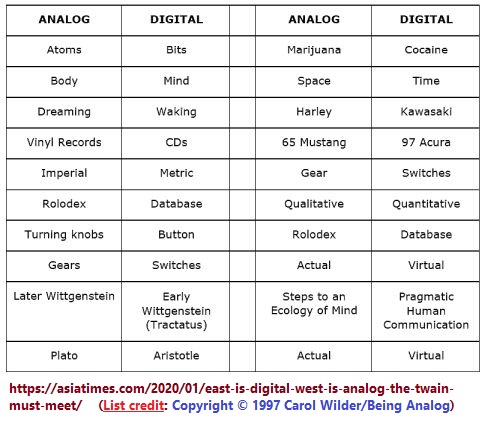
The author continues his essay:
Apart from its technical aspect, the analog-digital distinction also has a philosophical and aesthetic dimension. Leibniz credited the Chinese with having invented the first binary code. He referred to the 64 hexagrams that form the basis of the I Ching. The hexagrams are binary symbols the Chinese used to "quantize" nature in the binary opposites of yin and yang: dark/light, passive/active, death/life, contracting/expanding, space/time, human/nature. The aim of identifying these opposites was to reconcile them so that humans could "insert" themselves into the binary universe with the least amount of friction.
The I Ching not only forms the basis of East Asia's worldview, but it also shaped its culture, everything from its art and architecture to its social structure, its philosophy, and its aesthetic sensibilities. Distinguishing analog and digital is an art rather than a science, but if we apply Wilder's method of classifying analog and digital to East and West, we may conclude that the distinction found expression in their respective cultural development.
In this part of the author's referencing, we need to address the currency of thought regarding the I-Ching and the so-called "Trigrams". They are not in fact a "full-fledged" "three" conceptualization. It is a two-patterned orientation attempting to transition into a three which is causing problems of perception and misinterpretation of how far the Chinese have NOT gotten in their world-view as opposed to their desire for reaching the next step in human conceptualization. This is problematic not only for the East, but those of the West who foolishly misinterpret the I-Ching because the word "Triad" is being used instead of the correct "Biad". The eight so-called Triads of the I-Ching are actually Biads. The way to distinguish this in order to understand that the Chinese mentality is holding itself back by assuming some achievement in conceptualization that the Chinese culture has not achieved. Like the West, they are in a transition mode spinning their wheels.
Let us look at the so-called I-Ching eight triads, paying particular attention to the pairing (doubling) exercise being committed in creating the "stick" figures:
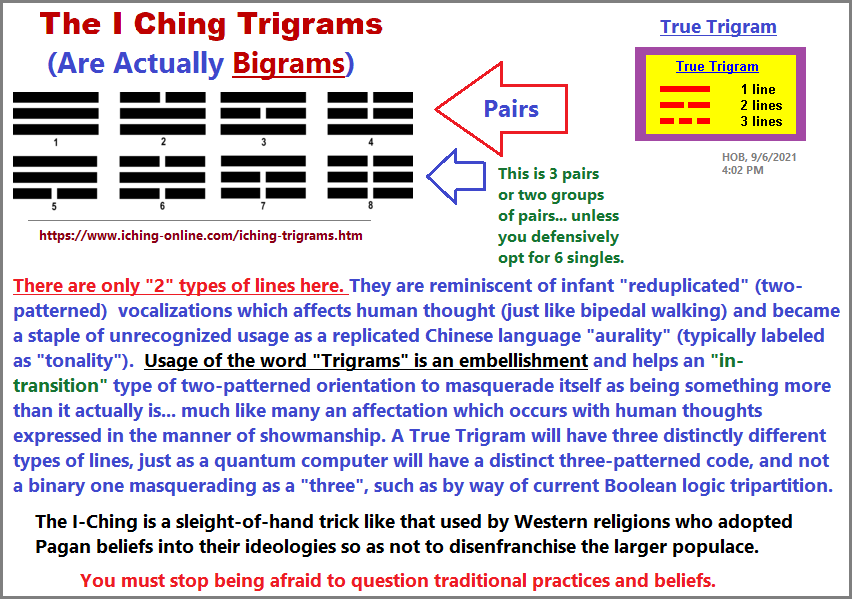
The last comments by the author displays the currency of thought regarding the Yin/Yang duality as an ancient attempt to conceptualize a remediation between positions that some readers are inclined to view as opposites.
If the ancient Chinese sages who conceived the yin-yang code had known about the analog-digital dichotomy, they may have classified it as one more yin-yang opposite that must be reconciled. The red thread running through the writing of Confucius, Lao Lao, and the other interpreters of the I Ching is the need to reconcile opposites, in the broadest sense of the word. One should be materialistic (yin) nor spiritual (yang), one should be both; realistic nor idealistic but both; conservative nor progressive but both. Had they lived today, the ancient sages may have added: One should be Eastern (yin) nor Western (yang); one should be both.
The problem with this line of thinking and the whole I-Ching scenario is that we fail to include the idea that Yin and Yang may not be a hybridization striving for some unification, but in a stage of transition which compels us to review the concepts of duality, pairing, and dichotomy as a mathematical word problem dealing with proportionalities which may not be half, but a distraction which prevents us from seeing yin and yang as part of a three-dimensional sphere which we are looking at as a flat, two-dimensional object... like looking at the Earth or Moon or Sun from one side where two continents are exposed and thus are interpreted to be the whole, but in fact another 1/3 exists, just as in the proportionalities we see many sub-atomic particles.
Despite the conceptualized imaginative drawing of the yin and yang symbol to convey and solidify the idea of perceived dualities being interconnected in life— this idea reeks of ego-centricity in much the same manner as it was once believed that the Earth was the Center of the Heavens. The Yin and Yang, defines human orientations to itself in its relation to the world as we know it. If there were as many non-gender people having lived during the stages of the Yin/Yang philosophy development, no doubt yin and yang would have a third component. We might be looking at some sort of Triskelion (also: Treskele). It is because we can find numerous Threes in Human Anatomy by Dr. McNulty and associates, and that Mature seems to love the Number three by Mark Mahin, as well as multiple subject fields provided by Michael Eck's The Book of Threes; it behooves us to reconsider what we mean by the values we are placing on our perceptions. If the Binary is so important, why are there other repeating patterns that we can numerically label? What if the Yin and Yang are not an actual duality but some other numerically identifiable theme, but because ancient peoples established a perception which became embraced by a culture of billions, people are afraid to question traditions and traditional views? Such a stance requires that we do not use terms such as "sages" when referring to ancient Chinese philosophers nor call ancient Greek philosophers as "Fathers", as if in doing so we are obligated to defer to their views instead of readdressing basic questions and basic views filtered through the centuries of knowledge we've created?
Is the Yin and Yang a hybrid or a single character humans have chosen to apply a dual theme to like some ancient mentality (for whatever reason) chose to mix and match two different parts together and create a hybrid beast which has no actual reality except in the minds of believers. Are we of today so ignorant, so very gullible as to accept the concoctions of hybridated ideas which ancient peoples supplied us with? What is wrong with present day humanity to accept such views of ancient peoples in both the East and West at whatever face value one or another tradition dictates for us to do so? Why has present day humanity embraced a Traditional stubbornness not to question traditions and traditional views... or in so doing, we do it with tongue-in-cheek in order to not anger some supposed god-like being watching over us; whereby we create rationalizations which serve as a talisman preventing us from being viewed in other than a light which serves to otherwise support and embolden some traditional belief? In other words, we are permitted to question so as to either validate a traditional view, belief or practice, or create a situation which solidifies some traditional perspective by casting a dubious shadow over any and all who would attempt to question that which is defined as real and practical reality by the quantity of people who share in such a tradition? Otherwise, those who persist in questioning by way of an increased insistence which takes on emotional overtones of conflict, can and will be labeled with some less than favorable label such as heretic, infidel, unbeliever, disturbed, insane, anti-social, misguided, etc.?
If fear is not the right word in describing those who would not think of questioning traditional views, then perhaps laziness... that we are too lazy to re-invent a perspective which has bogged us down? If not fear or laziness, is it merely one in which someone gets so caught up in their culture, their gender, their religion, academic subject, government, sport, entertainment, etc., that they literally can't see beyond its boundaries... and don;t want to if they could because all that they think they need is achievable where they are in their respective niche'?
- Fear of the unknown: One fear to rule them all? by Nicholas Carleton
- The Biology of Fear by Ralph Adolphs: ("Here I review the field and urge three
approaches that could reconcile the debates.")
- For one, we need a broadly comparative approach that would identify core components of fear conserved across phylogeny. This also pushes us towards the second point of emphasis:
- An ecological theory of fear that is essentially functional.
- Finally, we should aim even to incorporate the conscious experience of being afraid, reinvigorating the study of feelings across species.
- How to Overcome Your Fear of Making Mistakes by Alice Boyes, June 24, 2020
- A (macro) Sociology of Fear and Problem frames
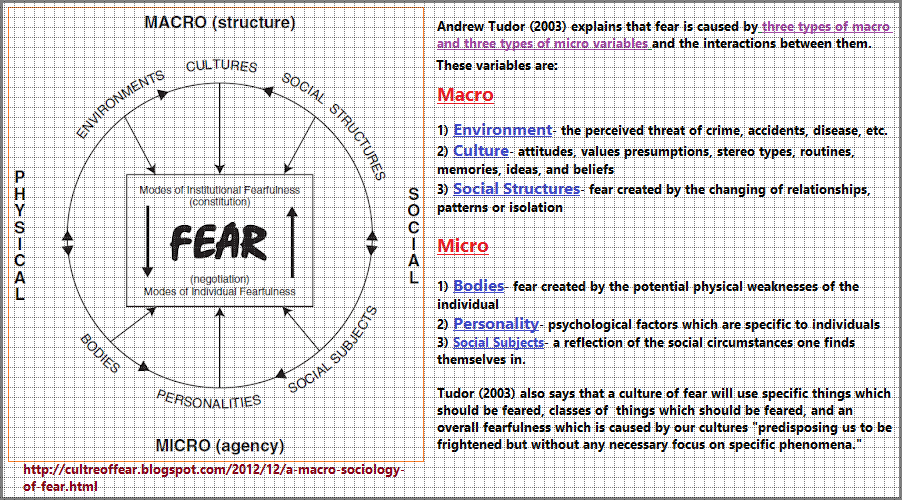
Another explanation for a culture of fear is the problem frame. The problem frame creates communication about, awareness of, and an expectation of danger (Altheide, 1997). According to Altheide (1997), Frames focus on:
- What will be discussed.
- How it will be discussed.
- (and above all), How it will not be discussed.
The problem frame tells a story with moral undertones which is specific and detailed (Altheide, 1997). They also focus on a problem that will resonate with the majority of viewers (Altheide, 1997). This fear created by the media may encourage more people to stay at home more often and consume more media, creating a cycle which generates more and more fear (Altheide, 1997). The news uses actual people to make their stories seem more relevant to a greater number of people. They present this information in a way which simplifies the overall story, focusing on a moral message instead of details (Altheide, 1997). With repeated exposure to similar stories, the viewer “"learns" that such incidents are common (even if they aren’t) (Altheide, 1997). The purpose of the problem frame is to suggest that a problem exists which effects a large number of people (Altheide, 1997). These people can easily identify this problem and feel it can be fixed. According to Altheide, "When certain problems can be cast within TV formats as arenas for disputes, disagreements, or conflicts and struggle, and when these can be visually illustrated, one has the formula for good entertainment, good audience ratings, constant awareness of problems, and a sense of a very troubled world." With increased public awareness (limited usually to how the media portrays the subject), politicians step in to enact more policies to keep us "safe" (Altheide, 1997). Altheide, D.L. 1997. The news media, the problem frame, and the production of fear. The Sociological Quarterly 38:647-68.
Let me provide a few more examples of the analog/digital divide from a typical and atypical perspective. The one on the right side implies that the notion of analog and digital can evolve to the point of development where previous ideological constraints must be cast into a framework emphasizing a form of evolution.
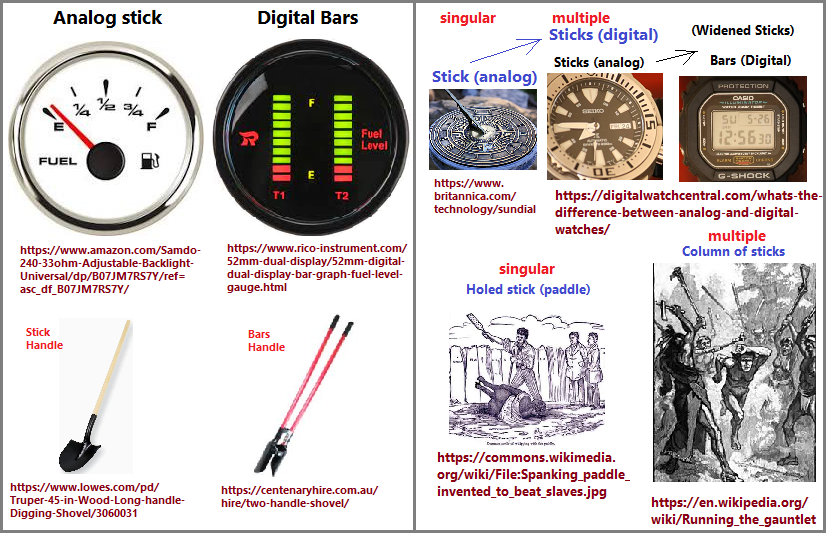
Date of Origination: Friday, 30th July, 2021... 6:38 AM
Date of Initial Posting: Saturday, 11th September, 2021... 4:38 AM